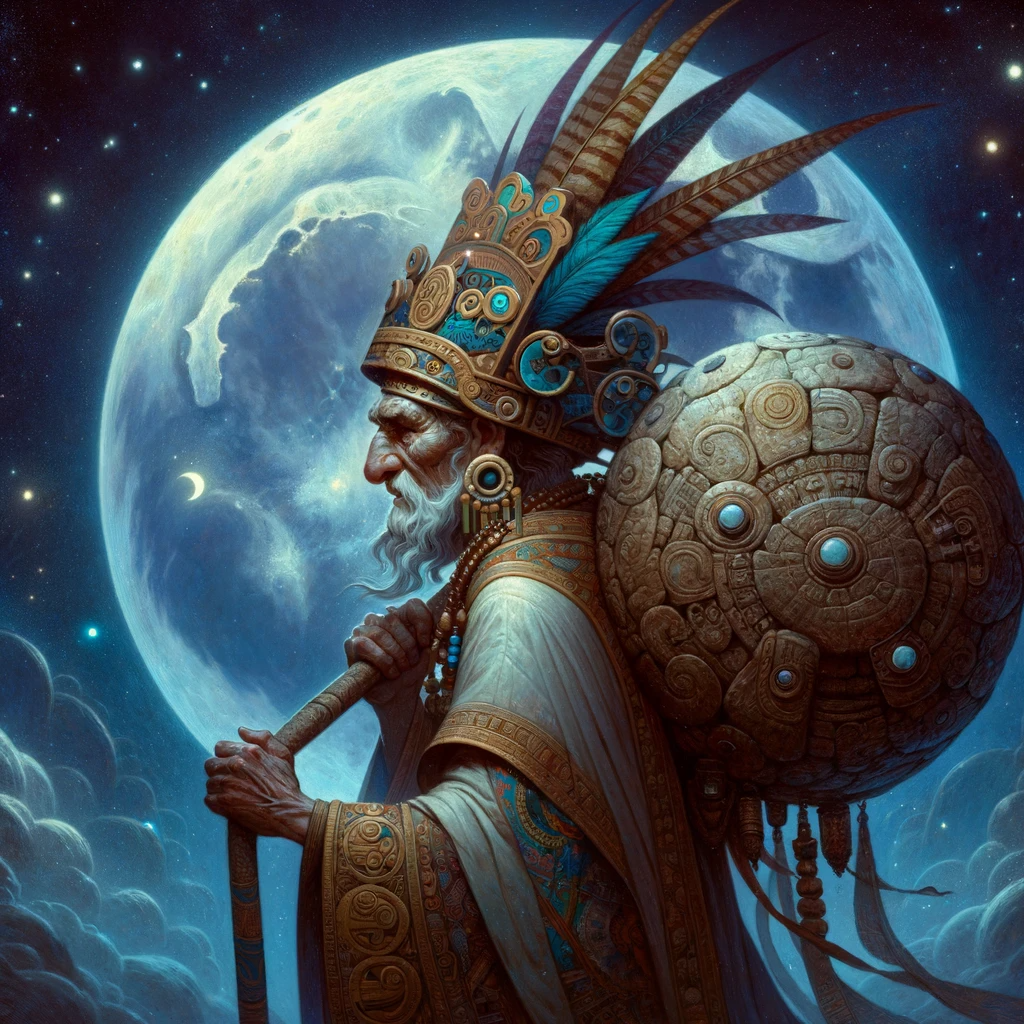
In the rich tapestry of Aztec mythology, Tecciztecatl stands out as a deity associated with the moon, reflecting the civilization's complex beliefs and cosmology. This deity's narrative is a testament to the Aztecs' intricate understanding of celestial phenomena and their religious practices that intertwined gods with natural elements and cosmic events.
Origins and Mythology
Tecciztecatl, often depicted as an old man carrying a large shell on his back, embodies the moon's phases and its influence over the night. His name, derived from the Nahuatl language, signifies "inhabitant of the land of the sea snail shell," pointing to the moon's perceived qualities and its impact on time measurement and agriculture among the Aztecs.
The myths surrounding Tecciztecatl illustrate his dual nature, embodying both light and darkness. He is sometimes portrayed as a god of light, reflecting the moon's ability to illuminate the night sky. Yet, he is also a figure of darkness, representing the moon's phases and its waning visibility.
The Legend of the Sun and the Moon
One of the most captivating myths involving Tecciztecatl revolves around the creation of the sun and the moon. In this narrative, the gods gathered to create the fifth sun, marking a new era for the world. Two volunteers were needed to jump into a sacred fire to become the sun and the moon. Tecciztecatl, despite his initial eagerness, hesitated due to fear. Contrarily, Nanahuatzin, a humble god, bravely leapt into the flames without hesitation, becoming the sun.
Tecciztecatl, after much coaxing and witnessing Nanahuatzin's transformation, finally jumped into the fire, becoming the moon. However, because of his hesitation and the gods' desire to not outshine the sun's brilliance, they dimmed Tecciztecatl's light by throwing a rabbit at him, explaining why the moon is less bright than the sun and bears the image of a rabbit.
Symbolism and Worship
Tecciztecatl played a significant role in Aztec religious ceremonies and was often invoked in rituals related to fertility and agriculture. The moon's cycles were integral to the Aztec calendar system, and Tecciztecatl's phases were closely observed for auspicious times to plant and harvest crops.
Artifacts and codices depict Tecciztecatl with symbols associated with lunar and nocturnal elements, such as shells, rabbits, and water motifs, underscoring his connection to the natural world and the cycles of life and death.
Legacy
The story of Tecciztecatl offers insights into the Aztec worldview, which was deeply connected to the cosmos. This deity's dual nature reflects the balance between light and dark, life and death, and the cyclic nature of existence that was central to Aztec belief.
Today, Tecciztecatl continues to fascinate scholars and enthusiasts of Mesoamerican cultures, serving as a reminder of the Aztecs' advanced astronomical knowledge and their profound reverence for the forces of nature. Through the legacy of Tecciztecatl, we glimpse the sophisticated religious practices and cosmological insights of one of the world's great ancient civilizations.
Origins and Mythology
Tecciztecatl, often depicted as an old man carrying a large shell on his back, embodies the moon's phases and its influence over the night. His name, derived from the Nahuatl language, signifies "inhabitant of the land of the sea snail shell," pointing to the moon's perceived qualities and its impact on time measurement and agriculture among the Aztecs.
The myths surrounding Tecciztecatl illustrate his dual nature, embodying both light and darkness. He is sometimes portrayed as a god of light, reflecting the moon's ability to illuminate the night sky. Yet, he is also a figure of darkness, representing the moon's phases and its waning visibility.
The Legend of the Sun and the Moon
One of the most captivating myths involving Tecciztecatl revolves around the creation of the sun and the moon. In this narrative, the gods gathered to create the fifth sun, marking a new era for the world. Two volunteers were needed to jump into a sacred fire to become the sun and the moon. Tecciztecatl, despite his initial eagerness, hesitated due to fear. Contrarily, Nanahuatzin, a humble god, bravely leapt into the flames without hesitation, becoming the sun.
Tecciztecatl, after much coaxing and witnessing Nanahuatzin's transformation, finally jumped into the fire, becoming the moon. However, because of his hesitation and the gods' desire to not outshine the sun's brilliance, they dimmed Tecciztecatl's light by throwing a rabbit at him, explaining why the moon is less bright than the sun and bears the image of a rabbit.
Symbolism and Worship
Tecciztecatl played a significant role in Aztec religious ceremonies and was often invoked in rituals related to fertility and agriculture. The moon's cycles were integral to the Aztec calendar system, and Tecciztecatl's phases were closely observed for auspicious times to plant and harvest crops.
Artifacts and codices depict Tecciztecatl with symbols associated with lunar and nocturnal elements, such as shells, rabbits, and water motifs, underscoring his connection to the natural world and the cycles of life and death.
Legacy
The story of Tecciztecatl offers insights into the Aztec worldview, which was deeply connected to the cosmos. This deity's dual nature reflects the balance between light and dark, life and death, and the cyclic nature of existence that was central to Aztec belief.
Today, Tecciztecatl continues to fascinate scholars and enthusiasts of Mesoamerican cultures, serving as a reminder of the Aztecs' advanced astronomical knowledge and their profound reverence for the forces of nature. Through the legacy of Tecciztecatl, we glimpse the sophisticated religious practices and cosmological insights of one of the world's great ancient civilizations.